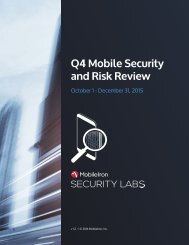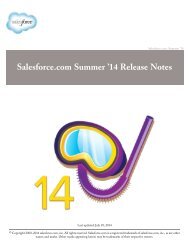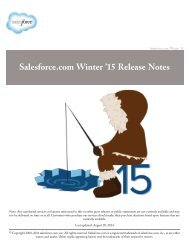salesforce_security_impl_guide
salesforce_security_impl_guide
salesforce_security_impl_guide
You also want an ePaper? Increase the reach of your titles
YUMPU automatically turns print PDFs into web optimized ePapers that Google loves.
Securing and Sharing Data<br />
Creating User Sharing Rules<br />
Creating User Sharing Rules<br />
Share members of a group to members of another group, or share users based on criteria.<br />
User sharing rules can be based on membership to public groups, roles, or territories, or on other<br />
criteria such as Department and Title. By default, you can define up to 300 user sharing rules,<br />
including up to 50 criteria-based sharing rules. Contact Salesforce.com for information about<br />
increasing these limits.<br />
User sharing rules based on membership enable user records belonging to members of one group<br />
to be shared with members of another group. Before you can create a membership-based user<br />
sharing rule, confirm that the appropriate groups have been created.<br />
Users inherit the same access as users below them in the role hierarchy.<br />
1. From Setup, click Security Controls > Sharing Settings.<br />
2. In the User Sharing Rules related list, click New.<br />
3. Enter the Label Name and click the Rule Name field to auto-populate it.<br />
4. Enter the Description. This field describes the sharing rule. It is optional and can contain up to<br />
1000 characters.<br />
5. Select a rule type.<br />
6. Depending on the rule type you selected, do the following:<br />
EDITIONS<br />
Available in:<br />
• Professional<br />
• Enterprise<br />
• Performance<br />
• Unlimited<br />
• Developer<br />
USER PERMISSIONS<br />
To create sharing rules:<br />
• “Manage Sharing”<br />
a. Based on group membership—Users who are members of a group can be shared with members of another group.<br />
In the Users who are members of line, select a category from the first drop-down list and a set of users from the<br />
second drop-down list (or lookup field, if your organization has over 200 groups, roles, or territories).<br />
b. Based on criteria—Specify the Field, Operator, and Value criteria that records must match to be included in the sharing<br />
rule. The fields available depend on the object selected, and the value is always a literal number or string. Click Add Filter Logic...<br />
to change the default AND relationship between each filter.<br />
7. In the Share with line, specify the group that should have access to the user records. Select a category from the first drop-down<br />
list and a set of users from the second drop-down list or lookup field.<br />
8. Select the sharing access setting for users.<br />
Access Setting<br />
Read Only<br />
Read/Write<br />
Description<br />
Users can view, but not update, records. They can see target<br />
users in list views, lookups, search, and interact with them on<br />
Chatter.<br />
Users can view and update records.<br />
59






